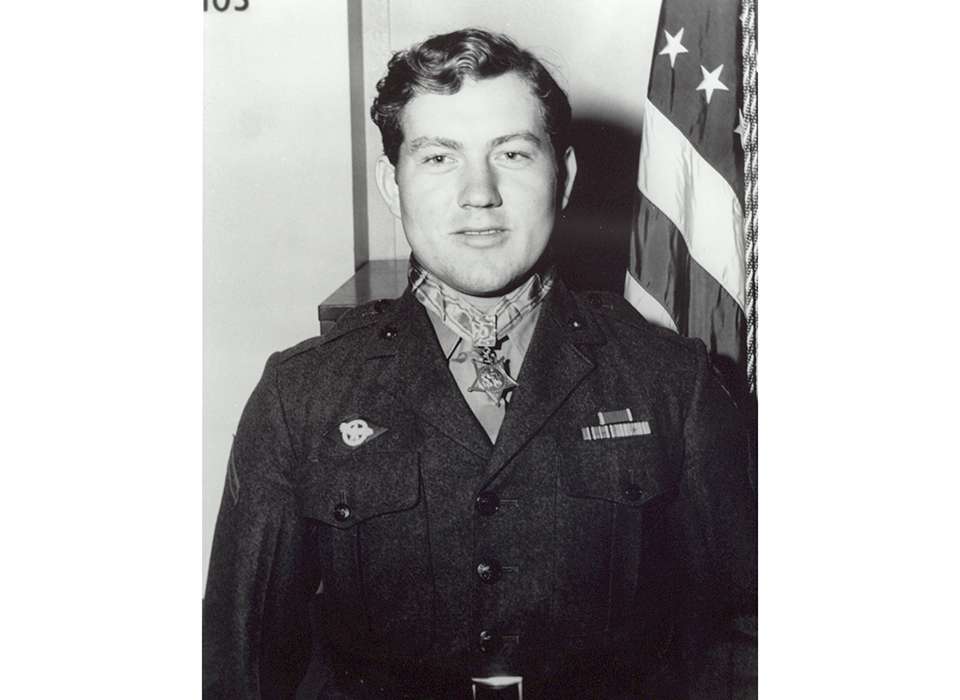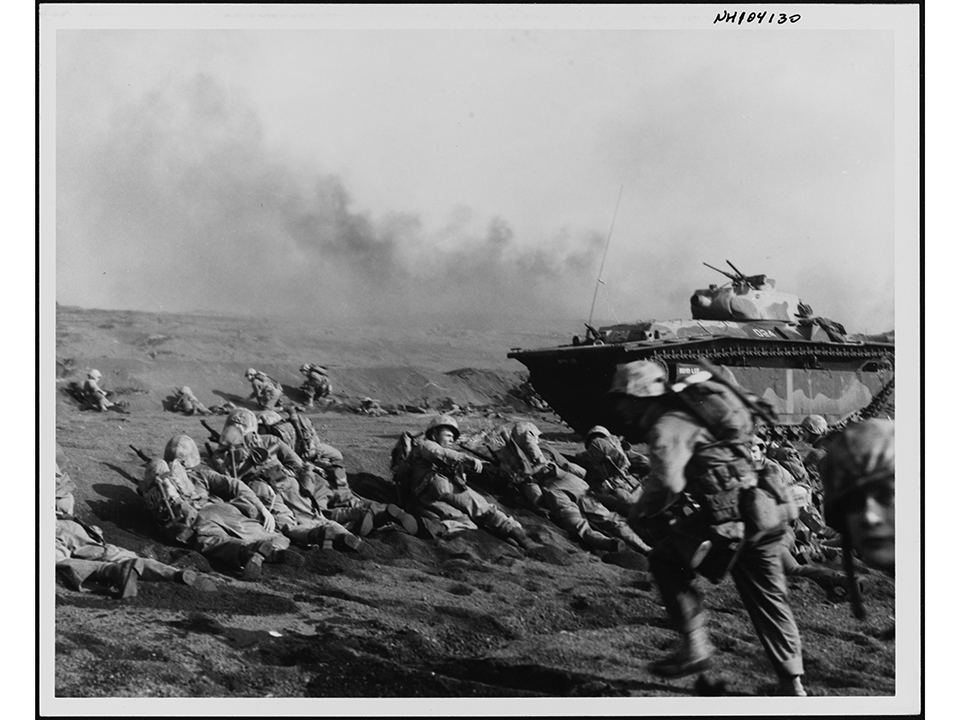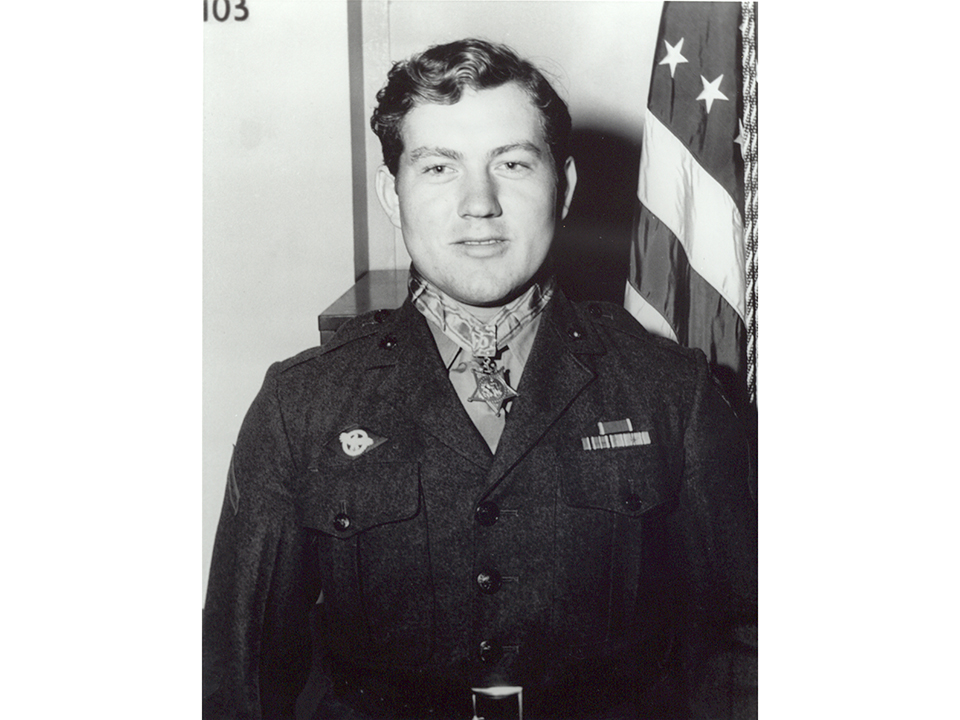Jacklyn “Jack” Lucas was born on February 14, 1928, in Plymouth, North Carolina. Lucas was always big for his age, and after the Japanese bombed Pearl Harbor, he was desperate to serve his country. While most 14-year-old boys contributed to the war effort through scrap drives and air raid drills, the audacious Lucas forged his mother’s signature so he could join the Marines. When the Marine Corps realized its mistake a year later, Lucas was relegated to driving a truck in Hawaii. Although Lucas was lucky not to have been immediately discharged, he was not willing to sit out the war in safety. Instead, he stowed away aboard the USS Deuel, a transport ship bound for Iwo Jima. Officers of the 26th Marines, unaware of the young Marine’s age, allowed Lucas to join their unit when they discovered him aboard the ship. Jack celebrated his 17th birthday at sea on February 14, 1945.
On the afternoon of February 19, Lucas landed on the Japanese-held island of Iwo Jima as a rifleman with the 1st Battalion, 26th Marines, 5th Marine Division. On Lucas’ second day in combat, two Japanese grenades fell into the trench he was sharing with three fellow Marines. Lucas was in the process of clearing a jam in his rifle and was the only one to notice the grenades. He yelled “grenade!” and pushed a fellow Marine out of the way. Lucas then threw himself on one grenade and pulled the other grenade underneath his body, pushing the small black cylinder as far into the black volcanic soil as he could. Seconds later, one of the grenades exploded, sending more than 250 pieces of shrapnel into Lucas, and causing grievous wounds throughout his body. Lucas was thrown into the air and landed on his back. Lucas’ comrades were sure he was dead and left the trench to continue their assault. Meanwhile, Lucas, who did not lose consciousness, could not make a sound and struggled to breathe. A Marine who happened to pass by saw Lucas and called for a Navy Corpsman. The Corpsman who came to Lucas’ aid not only treated his wounds, but also shot and killed another enemy soldier preparing to throw a grenade at the pair.
Stretcher bearers then carried Lucas to the beach, where he waited until nightfall to be evacuated to a hospital ship offshore. There he underwent the first of a series of 26 operations to remove some of the shrapnel from his torso, arm, and face. Lucas made a surprising recovery but underwent prolonged physical therapy to regain the use of his arm. Nearly eight months after Lucas’ heroic act, President Harry S. Truman presented Lucas with the Congressional Medal of Honor on October 5, 1945. Lucas was one of 27 servicemen to eventually be awarded the nation’s highest decoration for bravery during the Battle of Iwo Jima.
Incredibly, Lucas survived several other traumatic events after the war that rivaled his exploits as a Marine. After Lucas tried his hand at business for a time, he joined the Army in 1961 and trained as a paratrooper. On one training jump, both of his parachutes malfunctioned, sending him plummeting to earth. Miraculously, he survived the fall. Lucas credited his survival to a last minute roll and his stocky build. Lucas also escaped a fire that destroyed his home and an attempt by his then-wife to have him murdered. In light of these unbelievable escapes, Lucas fittingly titled his memoir Indestructible. Jack Lucas, the youngest Medal of Honor recipient since the Civil War, died on June 5, 2008, in Hattiesburg, Mississippi.
Tyler Bamford
Tyler Bamford was the Sherry and Alan Leventhal Research Fellow at the Institute for the Study of War and Democracy at The National WWII Museum from 2019-2021. He obtained his PhD in history from Temple University and his BA in history from Lafayette College.
Cite this article:
MLA Citation:
APA Citation:
Chicago Style Citation:










![Max Fuchs, New York City cantor, sings as Rabbi Sydney [sic] Lefkowitz, Richmond, VA, conducts the first Jewish services from Germany.](/sites/default/files/styles/max_650x650/public/2025-10/image1.jpg)

